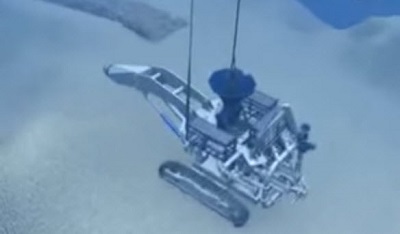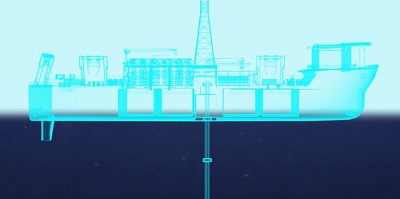Deepsea Copper Mine Versus Terrestrial Mines
Earth Economics has released an independent environmental and social benchmarking analysis of Nautilus Minerals’ proposed deep seabed mining project. The primary goal of the analysis was to measure the environmental and social impacts of the Solwara 1 project off Papua New Guinea in comparison with three terrestrial mines.
The report’s analysis is based on natural capital accounting and concludes that the Solwara 1 project has the potential to significantly reduce social and environmental impacts commonly associated with large surface terrestrial copper mines.
Specifically, the report compares Solwara 1 with three terrestrial mines: Bingham Canyon (Utah, U.S.), Prominent Hill (South Australia, Australia) and Intag (a proposed mine in Intag Province, Ecuador).
Solwara 1 is expected to be the world's first commercial high-grade seafloor copper-gold mine project. The mine site is approximately 30km (18 miles) from shore in the Bismarck Sea in around 1,600m (5,000 feet) of water. The site has indicated resources of one million tons grading 7.2 percent copper, five grams (0.18 ounces) of gold per ton, 23 grams (0.81 ounces) of silver and 0.4 percent zinc. Inferred resources add 1.5 million tons of 8.1 percent copper, 6.4 grams of gold, 34 grams of silver and 0.9 percent zinc.
Global Demand
Regarding the market conditions for the project, the report findings include:
• World demand for copper continues to rise, with increasing global economic development, expanding renewable energy supplies (wind, hydro, wave geothermal, tidal power) and growing copper plumbing, electronics and communications sectors.
• Recycling is likely limited to around 35 percent of the supply of copper. Copper ore concentrations are declining. Environmental and social impacts of copper mining are rising.
• There is an urgent need to meet world copper demand while reducing fresh water use and contamination, damaging impacts to communities, mine footprints and CO2 emissions from copper mining.
• Seafloor mining has the potential to minimize the impact of copper mining by producing more copper with fewer natural capital inputs, fewer damaging outputs and a smaller area of impact.
Environmental Impacts
The proposed Solwara 1 project, when compared to the terrestrial mines, entails far less environmental and social impact and less short and long-term risks, says Nautilus.
 The excavation and collection of mineralized material has been split into three individual tasks, which will each be carried out by a different seafloor production tool. The auxiliary cutter is designed as the pioneering tool which prepares the rugged sea bed for the more powerful bulk cutter. These two tools gather the excavated material; the third, the collecting machine, will collect the cut material by drawing it in as seawater slurry with internal pumps and pushing it through a flexible pipe to the subsea pump and on to the vessel via the riser and lifting system.
The excavation and collection of mineralized material has been split into three individual tasks, which will each be carried out by a different seafloor production tool. The auxiliary cutter is designed as the pioneering tool which prepares the rugged sea bed for the more powerful bulk cutter. These two tools gather the excavated material; the third, the collecting machine, will collect the cut material by drawing it in as seawater slurry with internal pumps and pushing it through a flexible pipe to the subsea pump and on to the vessel via the riser and lifting system.
Terrestrial mines have significant impacts. Measured on the basis of impacts per ton of copper, the Solwara 1 project would outperform terrestrial mines:
• People will not be displaced by the proposed Solwara 1 project
• There will be no impact to food production
• There will be no impact to surface or groundwater fresh water supplies
• There will be no significant risk of disaster (e.g. mine tailing slide into communities)
• There will be no impact to pollination, soil formation, erosion, historic and cultural values
• The monetary damages (measured in terms of USD/year) resulting from terrestrial mines is estimated to be significantly more than that of the proposed Solwara 1 project (4 to 13 times per ton of copper produced for the three mines used in the comparison).
• The long-term mining liabilities for freshwater contamination, tailings and overburden failures that threaten downstream communities do not exist in Solwara 1.
Mike Johnston, CEO of Canadian-based Nautilus, said, “Growing copper demand requires our industry to look at more sustainable ways to meet this demand. As showcased in Earth Economics' report, seafloor mining has the potential to not only provide economic benefits within the communities nearest to the operations while minimizing the impact of copper mining, it also has the potential to change the physical nature of the mining industry for the better.
“We believe that the proposed Solwara 1 project will launch a new frontier in the blue economy and resource sector. As the first publicly-listed company in the world to commercially explore seafloor mining opportunities, Nautilus is committed to leading the way and setting a high bar for developing an environmentally and socially responsible approach for the industry. Commissioning this report is part of our ongoing process to review, estimate and evaluate project impacts through objective third-party experts,” he added.
 Purpose Built Vessel
Purpose Built Vessel
It is anticipated that the proposed Solwara 1 project will commence operations in the first half of 2018 subject to project financing and completion of the company's seafloor production equipment and vessel. The production support vessel is being built in China by Fujian Mawei Shipbuilding.
Marine Assets Corporation (MAC), a marine solutions company based in Dubai which specializes in the delivery of new build support vessels for the offshore industry, will own and provide the marine management of the vessel. The vessel will be chartered to Nautilus for a minimum period of five years at a rate of US$199,910 per day, with options to either extend the charter or purchase the vessel at the end of the five year period.
When completed, the vessel will measure 227m (750 feet) in length and 40m (130 feet) in width with accommodation for up to 180 people and generate approximately 31MW of power. All of the below deck mining equipment will be installed in the vessel during the build process to minimize the equipment integration to be completed following delivery of the vessel. The vessel is expected to be delivered by the end of 2017.
Dispute Resolved
In 2013, an arbitrator ruled in favor of the Canadian company in a dispute with Papua New Guinea over the ownership of the Solwara project after a nearly two-year battle.
Nautilus had accused the government of not coming through on its share of financing for the project, while the government had accused Nautilus of not fulfilling some of its obligations.
The report is available here.
